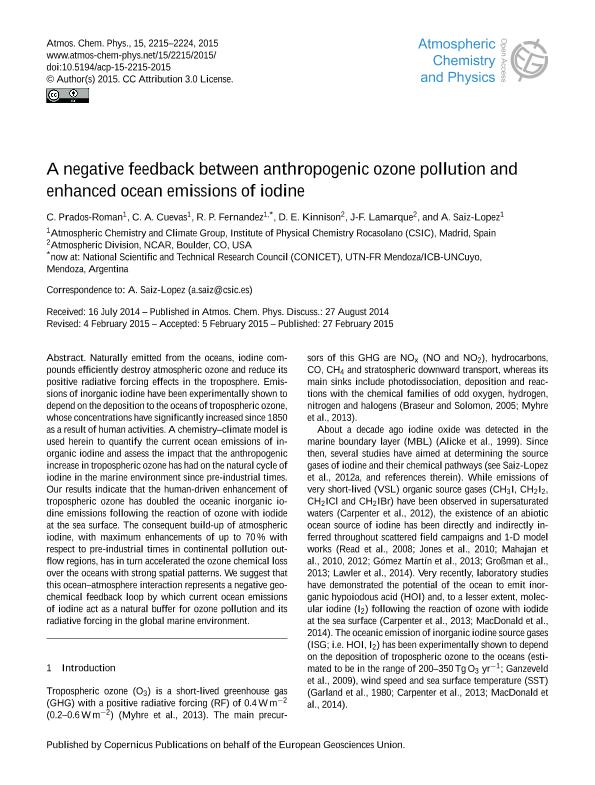Artículo
A negative feedback between anthropogenic ozone pollution and enhanced ocean emissions of iodine
Prados Roman, C.; Cuevas, Carlos Alberto; Fernandez, Rafael Pedro ; Kinnison, Douglas E.; Lamarque, Jean Francoise; Saiz-lopez, Alfonso
; Kinnison, Douglas E.; Lamarque, Jean Francoise; Saiz-lopez, Alfonso
 ; Kinnison, Douglas E.; Lamarque, Jean Francoise; Saiz-lopez, Alfonso
; Kinnison, Douglas E.; Lamarque, Jean Francoise; Saiz-lopez, Alfonso
Fecha de publicación:
02/2015
Editorial:
Copernicus Publications
Revista:
Atmospheric Chemistry and Physics
ISSN:
1680-7316
e-ISSN:
1680-7324
Idioma:
Inglés
Tipo de recurso:
Artículo publicado
Clasificación temática:
Resumen
Naturally emitted from the oceans, iodine compounds efficiently destroy atmospheric ozone and reduce its positive radiative forcing effects in the troposphere. Emissions of inorganic iodine have been experimentally shown to depend on the deposition to the oceans of tropospheric ozone, whose concentrations have significantly increased since 1850 as a result of human activities. A chemistry-climate model is used herein to quantify the current ocean emissions of inorganic iodine and assess the impact that the anthropogenic increase in tropospheric ozone has had on the natural cycle of iodine in the marine environment since pre-industrial times. Our results indicate that the human-driven enhancement of tropospheric ozone has doubled the oceanic inorganic iodine emissions following the reaction of ozone with iodide at the sea surface. The consequent build-up of atmospheric iodine, with maximum enhancements of up to 70% with respect to pre-industrial times in continental pollution outflow regions, has in turn accelerated the ozone chemical loss over the oceans with strong spatial patterns. We suggest that this ocean-atmosphere interaction represents a negative geochemical feedback loop by which current ocean emissions of iodine act as a natural buffer for ozone pollution and its radiative forcing in the global marine environment.
Archivos asociados
Licencia
Identificadores
Colecciones
Articulos(CCT - MENDOZA)
Articulos de CTRO.CIENTIFICO TECNOL.CONICET - MENDOZA
Articulos de CTRO.CIENTIFICO TECNOL.CONICET - MENDOZA
Citación
Prados Roman, C.; Cuevas, Carlos Alberto; Fernandez, Rafael Pedro; Kinnison, Douglas E.; Lamarque, Jean Francoise; et al.; A negative feedback between anthropogenic ozone pollution and enhanced ocean emissions of iodine; Copernicus Publications; Atmospheric Chemistry and Physics; 15; 4; 2-2015; 2215-2224
Compartir
Altmétricas



